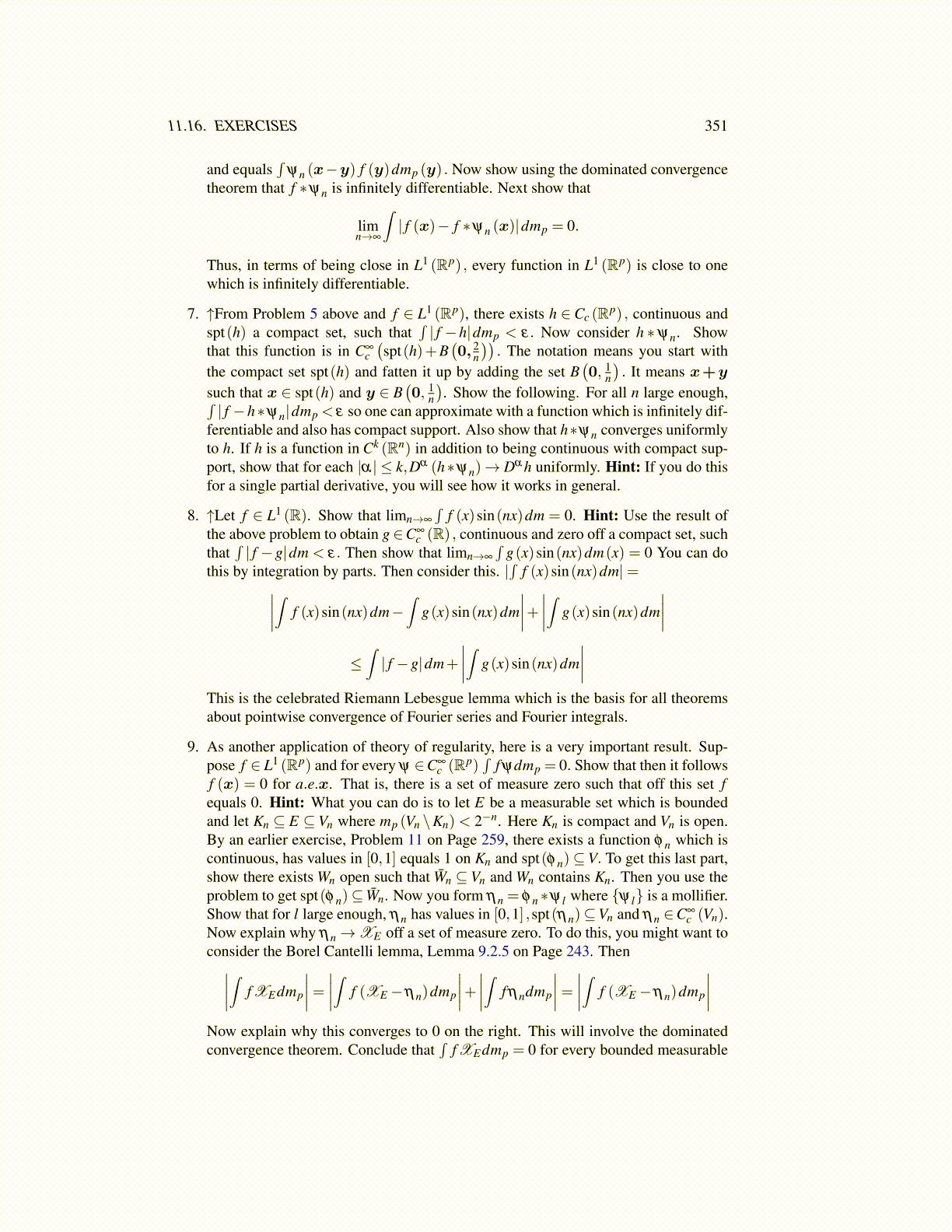
11.16. EXERCISES 351
and equals∫
ψn (x−y) f (y)dmp (y) . Now show using the dominated convergencetheorem that f ∗ψn is infinitely differentiable. Next show that
limn→∞
∫| f (x)− f ∗ψn (x)|dmp = 0.
Thus, in terms of being close in L1 (Rp) , every function in L1 (Rp) is close to onewhich is infinitely differentiable.
7. ↑From Problem 5 above and f ∈ L1 (Rp), there exists h ∈Cc (Rp) , continuous andspt(h) a compact set, such that
∫| f −h|dmp < ε. Now consider h ∗ψn. Show
that this function is in C∞c(spt(h)+B
(0, 2
n
)). The notation means you start with
the compact set spt(h) and fatten it up by adding the set B(0, 1
n
). It means x+y
such that x ∈ spt(h) and y ∈ B(0, 1
n
). Show the following. For all n large enough,∫
| f −h∗ψn|dmp < ε so one can approximate with a function which is infinitely dif-ferentiable and also has compact support. Also show that h∗ψn converges uniformlyto h. If h is a function in Ck (Rn) in addition to being continuous with compact sup-port, show that for each |α| ≤ k,Dα (h∗ψn)→ Dα h uniformly. Hint: If you do thisfor a single partial derivative, you will see how it works in general.
8. ↑Let f ∈ L1 (R). Show that limn→∞
∫f (x)sin(nx)dm = 0. Hint: Use the result of
the above problem to obtain g ∈C∞c (R) , continuous and zero off a compact set, such
that∫| f −g|dm < ε. Then show that limn→∞
∫g(x)sin(nx)dm(x) = 0 You can do
this by integration by parts. Then consider this. |∫
f (x)sin(nx)dm|=∣∣∣∣∫ f (x)sin(nx)dm−∫
g(x)sin(nx)dm∣∣∣∣+ ∣∣∣∣∫ g(x)sin(nx)dm
∣∣∣∣≤∫| f −g|dm+
∣∣∣∣∫ g(x)sin(nx)dm∣∣∣∣
This is the celebrated Riemann Lebesgue lemma which is the basis for all theoremsabout pointwise convergence of Fourier series and Fourier integrals.
9. As another application of theory of regularity, here is a very important result. Sup-pose f ∈ L1 (Rp) and for every ψ ∈C∞
c (Rp)∫
f ψdmp = 0. Show that then it followsf (x) = 0 for a.e.x. That is, there is a set of measure zero such that off this set fequals 0. Hint: What you can do is to let E be a measurable set which is boundedand let Kn ⊆ E ⊆ Vn where mp (Vn \Kn) < 2−n. Here Kn is compact and Vn is open.By an earlier exercise, Problem 11 on Page 259, there exists a function φ n which iscontinuous, has values in [0,1] equals 1 on Kn and spt(φ n)⊆V. To get this last part,show there exists Wn open such that W̄n ⊆Vn and Wn contains Kn. Then you use theproblem to get spt(φ n)⊆ W̄n. Now you form ηn = φ n ∗ψ l where {ψ l} is a mollifier.Show that for l large enough, ηn has values in [0,1] ,spt(ηn)⊆Vn and ηn ∈C∞
c (Vn).Now explain why ηn→XE off a set of measure zero. To do this, you might want toconsider the Borel Cantelli lemma, Lemma 9.2.5 on Page 243. Then∣∣∣∣∫ f XEdmp
∣∣∣∣= ∣∣∣∣∫ f (XE −ηn)dmp
∣∣∣∣+ ∣∣∣∣∫ f ηndmp
∣∣∣∣= ∣∣∣∣∫ f (XE −ηn)dmp
∣∣∣∣Now explain why this converges to 0 on the right. This will involve the dominatedconvergence theorem. Conclude that
∫f XEdmp = 0 for every bounded measurable